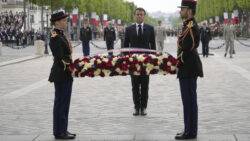French President Emmanuel Macron led the traditional ceremony on Paris’ Champs-Elysees Monday, commemorating the day that marked the end of World War II in Europe in 1945.
French President Emmanuel Macron led the traditional ceremony on Paris’ Champs-Elysees Monday, commemorating the day that marked the end of World War II in Europe in 1945.
Flanked by Prime Minister Elisabeth Borne, Macron laid a wreath at the Tomb of the Unknown Soldier under the Arc de Triomphe monument. A brass band played the Marseillaise.
Paris on VE Day
To limit disruptions amid ongoing opposition to Macron and his contested pension reforms, police banned gatherings around the area of the ceremony in the French capital, and in Lyon where the president traveled later in the day.
In Lyon, several streets were closed to traffic, some parking was prohibited and public transport disrupted.
Authorities are being vigilant to ensure that a “casserolade” or the loud banging of pots and pans in protest will not distract from the memorial ceremonies.
In Lyon, Macron paid to the French Resistance movement and one of its leaders, Jean Moulin. Macron visited Montluc prison, where Moulin was detained and tortured by the Gestapo.
French government
Every year, Victory in Europe Day is celebrated to commemorate Germany’s unconditional surrender that ended World War II on May 8, 1945. However, Russia and some countries of the one-time Soviet Union celebrate it on May 9 and call it simply Victory Day. Further West into Europe, this day is also known as Victory Day, Victory Over Fascism Day, or Liberation Day. In the UK and the US, it is shortened to VE Day or V-E Day.
France is one of just a few countries that has made Victory in Europe Day a public holiday, perhaps due to the devastating impact the war had on the country. French people frequently wear a bleuet (cornflower) on their lapel as a symbol of remembrance for those who died, similar to the Poppy worn by the British and other allies of the conflict.
(FRANCE 24 with AP)





